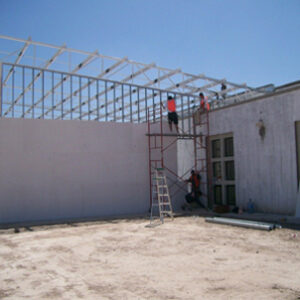 Installing MGO boards is a straightforward process that is similar to installing other types of sheathing or drywall, but with a few important considerations. Following these steps will help ensure a successful and long-lasting installation.
Installing MGO boards is a straightforward process that is similar to installing other types of sheathing or drywall, but with a few important considerations. Following these steps will help ensure a successful and long-lasting installation.
- Pre-Installation Preparation
- Acclimatization: Before installation, it’s crucial to let the MGO boards acclimate to the environment. Store them flat in the room where they will be installed for at least 48 hours to allow them to adjust to the temperature and humidity. This prevents future warping or cracking.
- Safety: Always wear appropriate personal protective equipment (PPE), including a dust mask, safety glasses, and gloves. Cutting MGO boards can produce fine dust.
- Tools: Standard carpentry tools are sufficient for most of the work. You’ll need:
- A tape measure and carpenter’s square for measuring.
- A utility knife or a circular saw with a carbide-tipped or diamond blade for cutting.
- A drill or screw gun for fastening.
- A level to ensure the boards are installed straight.
- Cutting the Boards
- Scoring and Snapping: For thinner boards (typically 8mm or less), the “score and snap” method is effective. Score a deep line on the board using a sharp utility knife and a straightedge. Then, apply pressure to the board to snap it cleanly along the scored line.
- Sawing: For thicker boards or for more precise cuts, a circular saw with a fine-toothed carbide or diamond blade is the best option. This method provides clean, straight cuts. A jigsaw can also be used for curved or irregular shapes.
- Safety Tip: Cut the boards in a well-ventilated area or use a dust extraction system to minimize dust exposure.
- Fastening the Boards
- Frame Preparation: Ensure the framing (wood or steel studs) is straight, square, and provides adequate support.
- Fasteners: Use high-quality, corrosion-resistant screws. Stainless steel screws are highly recommended, especially in high-moisture environments, to prevent corrosion from the board’s chemical composition (particularly with magnesium chloride-based boards).
- Spacing:
- Place fasteners at least 1/2 inch (12 mm) from the board edges and 2 inches (50 mm) from corners to prevent cracking.
- Fasten the boards with screws spaced every 6 inches (150 mm) along the perimeter and every 12 inches (300 mm) in the field (the middle of the board).
- Technique: Start fastening from the center of the board and work your way outwards to prevent stress and bowing. Ensure the screw heads are countersunk just below the surface of the board, but do not overtighten, as this can crack the board.
- Finishing the Joints and Surface
- Expansion Gaps: Leave small gaps between the boards (typically 1/16 to 1/8 inch or 1.5 to 3 mm) to allow for minor expansion and contraction.
- Joint Treatment:
- Apply a fiberglass mesh tape over all seams between the boards.
- Use a high-quality joint compound suitable for cementitious materials to fill the gaps and cover the tape. Apply in thin layers, feathering the edges for a seamless finish.
- Allow the compound to dry completely, then sand the joints smooth.
- Priming and Painting:
- Once the joints are smooth, clean the entire surface of the MGO board to remove any dust.
- Apply a high-quality acrylic or latex primer designed for concrete or masonry to ensure proper adhesion.
- After the primer is dry, you can apply paint, wallpaper, or other finishes.
- Wet Area Finishing: For applications in wet areas like bathrooms or as a tile backer board, it is essential to apply a waterproofing membrane over the MGO board before tiling.
16
SEP
2025
SEP
2025
0
